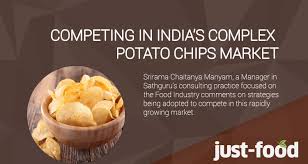
Overview of India’s Potato Chips Market
India’s potato chips market has evolved significantly over the past decade, reflecting broader changes in consumer preferences, economic conditions, and industry dynamics. As of 2024, the market is characterized by strong growth, competitive dynamics, and shifting consumer trends. This deep dive explores the current state of play in India’s potato chips market, focusing on market size, key players, consumer trends, and challenges.
Table of Contents
Market Size and Growth
Expanding Market
India’s potato chips market is witnessing robust growth, driven by increasing urbanization, rising disposable incomes, and changing lifestyles. According to recent industry reports, the market size is expected to surpass INR 30,000 crore (approximately USD 3.6 billion) by the end of 2024. This growth trajectory is supported by both domestic consumption and expanding distribution networks.
Growth Drivers
Several factors contribute to the market’s expansion:
- Urbanization: As more people move to urban areas, the demand for convenient and ready-to-eat snacks like potato chips has surged.
- Economic Growth: Rising disposable incomes have increased consumer spending on premium and branded snacks.
- Changing Lifestyles: Busy lifestyles and evolving dietary preferences have made packaged snacks a popular choice.
Key Players in the Market
Leading Brands
The Indian potato chips market is dominated by a few major players who have established strong brand presence and extensive distribution networks. The leading brands include:
- Lay’s (PepsiCo): As a global leader, Lay’s maintains a significant share of the market with a diverse product portfolio and aggressive marketing strategies.
- Pringles (Kellogg’s): Known for its unique packaging and flavors, Pringles has carved out a niche in the premium segment.
- Bingo! (ITC Limited): Bingo! has gained popularity with its varied flavors and regional appeal, focusing on both traditional and innovative offerings.
Regional Players
In addition to the major brands, several regional players have gained traction by catering to local tastes and preferences. Companies such as Haldiram’s and Kurkure (PepsiCo) have successfully penetrated niche markets with products tailored to Indian palates.
Consumer Trends
Flavor Innovation
Flavor innovation is a key trend driving growth in the potato chips market. Consumers are increasingly seeking unique and bold flavors beyond traditional variants. Brands are experimenting with regional and exotic flavors to cater to diverse tastes and preferences.
Health Consciousness
There is a growing awareness of health and wellness among Indian consumers, leading to a demand for healthier snack options. This trend has prompted brands to introduce low-fat, baked, and non-fried variants of potato chips, as well as products with natural ingredients and fewer additives.
Packaging and Convenience
Convenience and packaging innovation play a crucial role in consumer purchasing decisions. Single-serve packs, resealable bags, and eco-friendly packaging options are becoming increasingly popular as consumers seek more convenient and sustainable choices.
Distribution Channels
Retail Landscape
The distribution of potato chips in India spans various channels, including:
- Modern Trade: Supermarkets and hypermarkets are significant distribution points, providing consumers with a wide range of choices and brands.
- Traditional Retail: Local kirana stores and smaller retail outlets remain important, especially in rural and semi-urban areas.
- E-commerce: Online platforms are gaining traction as a growing number of consumers turn to digital shopping for convenience and better deals.
Regional Variations
Distribution strategies often vary by region, with companies tailoring their approaches to local market conditions and consumer preferences. Urban areas typically see more extensive distribution networks, while rural regions may rely more on traditional retail channels.
Challenges Facing the Market
Raw Material Costs
The cost of raw materials, particularly potatoes, can be volatile and impact profitability. Fluctuations in potato prices due to factors like weather conditions and supply chain disruptions pose challenges for manufacturers.
Competition and Price Wars
The competitive landscape is intense, with both established and emerging players vying for market share. Price wars and promotional strategies are common, affecting profit margins and requiring brands to continuously innovate and differentiate themselves.
Regulatory Issues
Compliance with food safety and labeling regulations is crucial for market players. Adhering to stringent regulations and managing quality control are ongoing challenges that require constant attention.
Conclusion
India’s potato chips market is on a strong growth trajectory, driven by urbanization, economic development, and changing consumer preferences. Key players continue to innovate and adapt to evolving trends, while regional and local brands also play a significant role. However, challenges such as raw material costs, intense competition, and regulatory compliance need to be navigated carefully. As the market continues to evolve, understanding these dynamics will be crucial for both established brands and new entrants seeking to capitalize on the opportunities in India’s snack industry.









